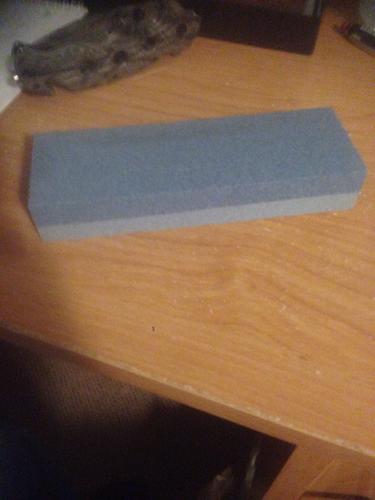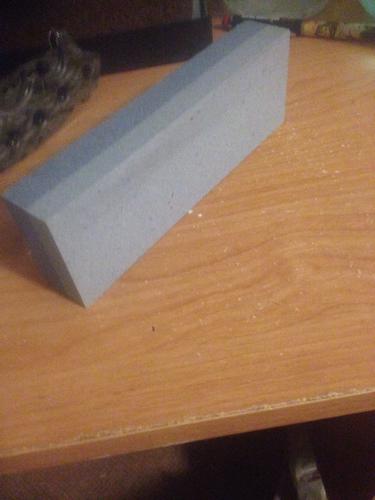Results 1 to 10 of 13
Thread: How to tell the grit of a hone?
-
04-26-2015, 07:22 PM #1
 How to tell the grit of a hone?
How to tell the grit of a hone?
I recently was at Dollar Tree with the girlfriend to get some tissue paper for a gift she was putting together. I walked down the tools and hardware isle and found a little 6 inch double sided stone. The brand is "Tool Bench Hardware" I paid $1.25 for it so I don't expect much. It feels low grit compared to my lowest 400 grit stone which feels smooth. How would I tell the grit. I'm mainly going to use it for knives. The question I have is which is the best way to determine grits or is there?


-
04-26-2015, 07:32 PM #2

Experience.
Lacking that you can take some slurry and check it under a mike that has a measuring function.Plus ça change, plus c'est la même chose. Jean-Baptiste Alphonse Karr.
-
04-26-2015, 08:28 PM #3

Often times you just have to use it and see what happens.
No matter how many men you kill you can't kill your successor-Emperor Nero
-
04-26-2015, 08:43 PM #4

Agree with all above... Saying that the hone you bought are not for straight razors. I wouldn't use it for my kitchen knifes either. Only knifes for the garden and cutting.
You can measure the grid, or grind if you like. But that's really not nessesary. With naturals grid is normal 1k and up to 12-15k some naturals are good as finishers and some as starters.
The Cretan oil hone is good as a starter and coticule are good as a finisher.
Your hone is a synthetic and properly around 250 grid.Last edited by Kristian; 04-26-2015 at 08:46 PM.
-
04-26-2015, 08:49 PM #5Senior Member




- Join Date
- Feb 2013
- Location
- Haida Gwaii, British Columbia, Canada
- Posts
- 14,443
Thanked: 4828
I have no real idea. What if think is more important is the question of is it high enough grit to use with razors, and after that the next question is where does it fit in the progression. It does not look like it passes the first question. Really low grit, 200 and 400 are often seen in the hardware stores and dollar stores. Super thirsty with loose grit is the one that I have. I use mine for taking chips out of chisels and not much else, I suppose it would work for bevel setting on a hatchet or axe.
It's not what you know, it's who you take fishing!
-
04-26-2015, 09:26 PM #6

You can find a piece of iron/steel, grind it, and see how deep the scratches are. I find this to be the most reliable method, as long as your stone is lapped. After that, it's experience.
Or you can lick it and see how long it takes for your tongue to start bleeding
-
04-26-2015, 09:28 PM #7
 How to tell the grit of a hone?
How to tell the grit of a hone?
I would never use it on my razors. I cherish them!! I however need to sharpen my chisels they are nicked and beat up. Garden tools and outdoor knifes I'm going to use it for, keeping it in my travel bag. I just thought for $1.25 why not.
I know what this stone should be used for just wanted grit estimates and suggestions!
( I have different types of razor hones, 400g 1k 3k 8 k and a couple coticules, this isn't my first rodeo so to speak.. Not that I really know how to use them all )
)
Last edited by s0litarys0ldier; 04-26-2015 at 09:37 PM.
-
04-26-2015, 09:33 PM #8
-
04-26-2015, 09:43 PM #9

Just call it course and extra course.
"The best way to have a good idea is to have a lot of ideas." -Linus Pauling
-
04-26-2015, 10:32 PM #10Senior Member

- Join Date
- Aug 2014
- Location
- Argentina
- Posts
- 108
Thanked: 9
Just to add a little bit to the confusion: I agree with what has been stated, regarding testing, but would also add that some brand new stones "feel" smoother/finer just because of surface finish; it becomes coarser after a couple of uses.


 6Likes
6Likes LinkBack URL
LinkBack URL About LinkBacks
About LinkBacks







 Reply With Quote
Reply With Quote

